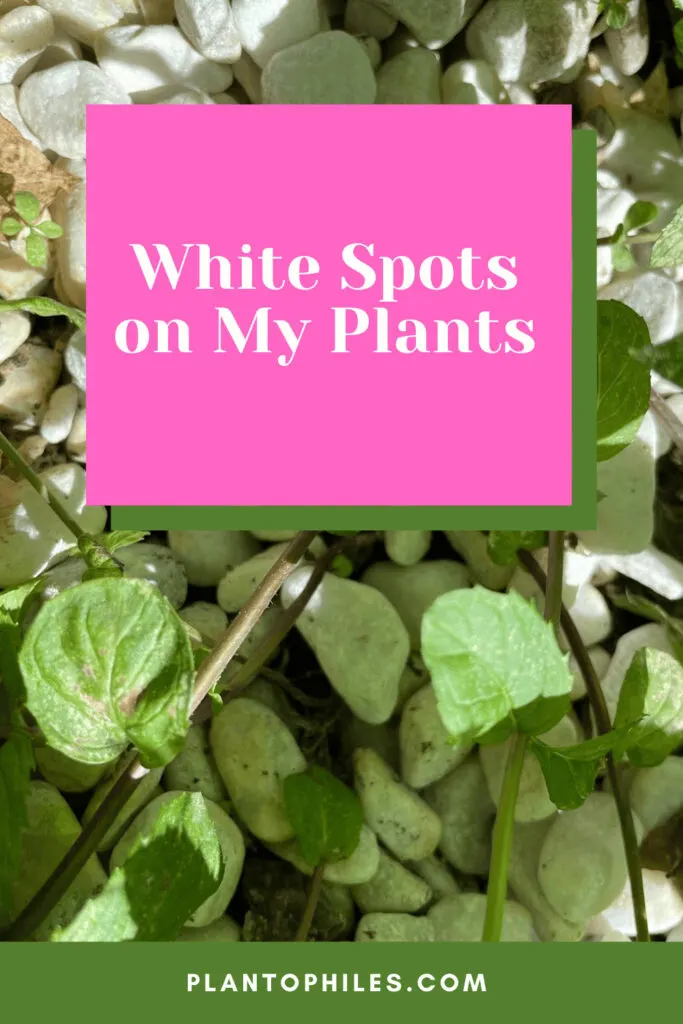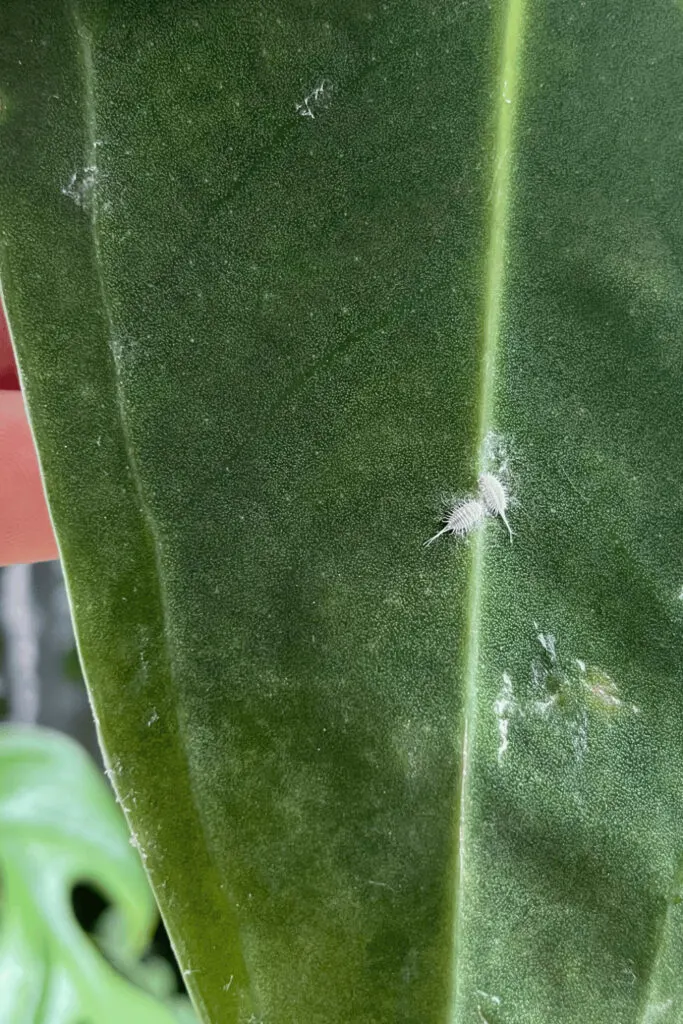I adore lush green plants, foliage, and vegetation, especially in my home. So when I saw that beautiful houseplant start to look like someone dusted them with cake frosting, I became worried.
Indeed, these weren’t the beautiful begonias and jade plants I had so carefully cared for? And what was worse, the white powder spread almost overnight!
Not knowing what this white substance was, I tried wiping it off with a damp cloth, only to have it return the next day exponentially.
My first instinct was that this was a kind of mealybug spotting all over the broadsides of my plant leaves, but then I saw that pesticides did nothing to repel them.
Desperate, I began researching and found these white spots weren’t insects or pests.
Table of Contents
White Spots on Plant Leaves
White spots on plant leaves are a special fungus or mildew known as powdery mildew that spreads all over plants, especially indoor plants. Growing fast, the mildew spreads from airborne spores and can rapidly infect plants, and it doesn’t take long before plants start wilting and rotting away.

4 Reasons for White Powdery Mildew to Form
Like the bread mold that quickly digests the yeast in your bread, white powdery mildew loves specific conditions that give it that extra growth kick.
1. Mild to Warm Temperatures
White powdery mildew needs mild to warm temperatures to thrive.
It especially prefers 70℉ as this stimulates the production of mycelium or spores that allow the mildew to reproduce and spread.
2. Lack of Air Movement
Since the spores need to remain close to the leaf surface to have the best chance of adhering, a lack of air movement is also required.
If there is too much wind, the spores will scatter once released, and the white spots won’t form.
3. Poor Lighting Conditions
White powdery mildew likes to grow in dark or semi-dark lighting conditions.
Too much strong sunlight or even artificial solid light will cause the mildew to die.
4. Humidity
Outdoor white powdery mildew prefers more humid conditions, allowing the spores to scatter better, and a damp leaf will more readily absorb the mildew spores as they land.
Indoor white powdery mildew prefers a less humid climate, and the leaves can be quite dry and still receive a burden of mildew spores.
Since there is usually less wind indoors, the chances of the spores scattering will be reduced so the plant leaves don’t have to be moist for the spores to stick on.
How to Get Rid of White Specks on Plants
So, as I stated, wiping down the leaves of your plants to try and remove those white powdery mildew spots may not be the answer to getting rid of white spots.
Instead, you may spread the spores even more or cause spores to be deposited from infected leaves onto healthy leaves.
Instead, do these tips:
1. Wipe With a Vinegar Solution
Mix a weak vinegar solution as white powder mildew doesn’t like an acidic liquid. I like mixing one teaspoon of white vinegar with a half-gallon of water and spraying it from the roots.
Follow this by wiping all leaves with a clean terry cloth.
2. Spray With Soapy Solution
Another great way to get rid of white powdery mildew is to mix a tablespoon of baking soda and a few drops of dishwashing liquid in a four-gallon container with water.
Spray the affected plant with the liquid and then water the roots well.
If the liquid simply runs off the white powdery spots, you may need some help getting the solution to soak the mildew spots.
An excellent way to do this is to mix in a teaspoon of neem oil or agricultural oil with the soap mix.
3. Remove Sickly Leaves Immediately
If your plant starts to look sickly, you may need to remove all badly affected leaves and stems as these can cause reinfection, and removing them is best.
Be sure to use a sharp blade to cut the leaves away, and when you are done, dispose of the affected cuttings far away from your plants.
Also, wash your hands to prevent spores that may be on your hands from setting up shop in your plants again.
Spraying with a fungicidal may also help, and you can even sprinkle some cinnamon powder on your plants to work as a natural fungicidal treatment.
White Spots on Plant Leaves Not Mildew
If you find white spots on your plants, but you can rule out powdery mildew, it can have other reasons. It can be from stress or nutrient deficiency, or viruses or pests can cause it.
Here is an example of my Anthurium warocquenanum plant. From afar, I see white spots on the leaves. The spots are mainly on the underside. Once I go closer, I can identify mealybugs. These pesky insects spread quickly on plants and start to suck the sap.

Frequently Asked Questions about White Spots On My Plants
What do white spots on plants mean?
These tell-tale signs are usually the calling card of white powdery mildew, a highly contagious and fast-growing mold. Powdery white mildew starts as circular white spots, which is how the spores are released, creating a white circle around the spore seeding point. Over time, these spots weaken the plant’s structural integrity, and the leaves will wilt and die. Acting quickly when white spots appear on your plants is essential to save your plants.
Can powdery mildew be cured?
White powdery mildew is easily cured by acting quickly, removing infected leaves, spraying with alkaline household remedies like milk and baking soda, or applying an antifungal oil like neem oil. Be sure to repeat as many times as required to rid yourself of any reinfestation of the dreaded white powdery mildew.
Can powdery mildew harm humans?
Powdery white mildew is very harmful to humans if ingested or inhaled. If you are working with a plant infected by these white spots, it is advisable to work outside where there is better airflow and wear a face mask to limit exposure to microscopic spores. Some people are severely allergic to mold spores, and white powdery mildew is a particularly aggressive mold reproducing through spores. A plant or affected object near you can trigger allergic reactions, cause breathing complications, and lead to eczema.
The Final Spot
White powdery mildew has the potential to ruin a plant. Acting quickly helps your chances of winning the fight against the microscopic spores that mildew releases daily.
Be sure to wear protective respiratory equipment when you work with infected mold plants.
You can beat white powdery mold by reducing the conditions that favor its spread and acting as soon as you notice those fluffy white spots on your verdant green plants.

Daniel has been a plant enthusiast for over 20 years. He owns hundreds of houseplants and prepares for the chili growing seasons yearly with great anticipation. His favorite plants are plant species in the Araceae family, such as Monstera, Philodendron, and Anthurium. He also loves gardening and is growing hot peppers, tomatoes, and many more vegetables.


